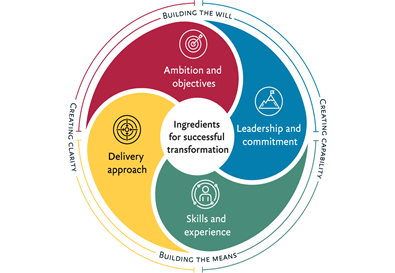The first article in this two-part series discussed the toolkit’s steps on leadership and understanding the drivers of change. Now we explore how to set an effective strategy, embed change and ensure continuous evolution.
We partnered with not-for-profit organisation Chapter Zero to develop the Board Toolkit, helping businesses to respond strategically and effectively to the net zero challenge.

3. Set a clear ambition and roadmap for net zero
Define a clear vision and set of SMART strategic objectives for your business, defining what you aim to achieve and by when in responding to climate change and the net zero imperative. Then establish how and where your business and end-to-end value chain need to change to achieve these goals, before creating a clear multi-year roadmap to deliver that change.
Once developed, embed your climate and net zero strategy as an integral part of strategic planning and competitive positioning for your organisation as whole.
Critical success factors
- Engage key stakeholders inside and outside the organisation throughout the process. Secure input, alignment and action across your entire value chain, both upstream and downstream.
- Ensure that emissions reduction goals are based on credible, science-based targets, consistent with a 1.5C future.
- Follow a ‘reduction-first’ approach to tackling emissions, with offsetting used only to compensate for residual emissions that are not feasible to eliminate.
- Ensure that you build flexibility, adaptability and responsiveness into your strategy by planning for the various scenarios you developed when assessing the drivers of change.
4. Embed and sustain the change to achieve your net zero goals
In many organisations, delivering net zero will require a comprehensive transformation impacting all areas of the business.
Critical success factors
- Resourcing. Ensure that sufficient resources (human and financial) have been allocated to deliver the change – both in your own organisation and within partners across the end-to-end value chain.
- Oversight. Ensure that the right metrics, mechanisms and oversight are in place to track and independently verify achievement of goals.
- Performance. Ensure that strategic targets are cascaded throughout the organisation and embedded in people performance objectives/metrics to align behaviours and decision making with strategic direction on net zero.
- Capability. Ensure effective communication, engagement, education and training are in place to equip the people in your organisation and more broadly, with an understanding of the need to change – and with the right skills and knowledge to make the change happen.
- Alignment. Ensure all activities and leadership behaviours are consistent with your climate/net zero strategy e.g. senior leadership should lead by example; your organisation’s political lobbying, whether undertaken directly or via trade association membership, should be strategically aligned, etc.
- Governance. Building on the earlier points on leadership, ensure that corporate governance is updated and optimised to align with the principles defined by the World Economic Forum. In particular, ensure that broader decision making takes account of climate and net zero implications.
5. Keep monitoring, learning and improving on net zero action
Stakeholder sentiment, innovations in low-carbon technology, climate legislation and our understanding of climate science, continue to change at a bewildering rate. It’s therefore vital that your strategy, targets and plans keep evolving.
Critical success factors
- Horizon scan. Review and regularly assess the impact of emerging trends in sentiment, low-carbon technology, climate legislation, net zero best practice, etc.
- Monitor. Continuously monitor progress towards your stated goals, taking remedial action where targets are not being met, and updating targets where needed.
- Listen. Set up channels to continue capturing and acting on ideas and insights from all key stakeholders, including employees, lenders, investors, customers, suppliers, etc.
- Collaborate. Proactively collaborate on an ongoing basis to share and action improvement ideas and innovations. This should take place across the end-to-end value chain and with other businesses and stakeholders, both within your sector and more broadly. You may even extend this to pre-competitive collaboration within your sector to accelerate net zero progress and deliver mutual advantage.
- Incentivise. Consider opportunities to incentivise stakeholders to develop improvement ideas. These do not necessarily have to be monetary. For example, competitions to develop the best ideas or make the biggest difference can be a great way to raise awareness and drive positive engagement.
- Benchmark. Regularly and proactively compare ambition, action and achievement with peer and comparator organisations – adjusting your plans and targets accordingly.
Act now on net zero to ensure future business viability
Climate change and the transition to net zero are creating a period of unparalleled change, risk and opportunity for businesses in all sectors. By taking the actions outlined in the Chapter Zero Board Toolkit, you can ensure you are set up for success.
But the time to act on them is now. It’s not only the right thing to do for the environment, but essential to the future viability and success of your business.











